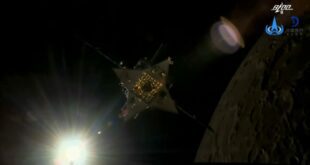
The United States is alleging that two Russian satellites are stalking a U.S. National Reconnaissance Office (NRO) reconnaissance satellite in low-Earth orbit (LEO), and has formally complained about the matter to the Russian government according to numerous press reports.
According to the United States, a Russian geodetic satellite called Cosmos-2542 that is believed to possess a satellite inspection capability was launched from Russia’s Plesetsk Cosmodrome on 25 November 2019. On 6 December 2019 Cosmos-2542 released a smaller satellite called Cosmos-2543, and on 21 January 2020 the two Russian satellites altered their orbits in order to match the orbit of the U.S. NRO satellite, believed to be one of its KH-11 extremely high resolution reconnaissance satellite, called USA-245.
Within two days of the Russian satellites’ orbital alterations, the NRO moved USA-245 so that there was a minimum distance of 500 kilometres between it and Cosmos-2542 and Cosmos-2543. Yet despite this defensive maneuver, and due to orbital mechanics, the Russian satellites are still close enough to potentially gather valuable intelligence on the capabilities of USA-245 using optical and electronic measurement sensors, and, according to some observers, the Russian and U.S. satellites will likely make at least one close pass (less that 100km distance) of each other by late February 2020.
General John ‘Jay’ Raymond, the Commander of the U.S. Space Force, has told reporters that, “We view this behaviour as unusual and disturbing…It has the potential to create a dangerous situation in space.”
Additionally, General Raymond has stated that this incident involving the Cosmos-2542 and -2543 satellites are “behaving similar to another set of satellites that Russia deployed in 2017, and which the Russian government characterised as ‘inspector satellites’.”
For its part, the Russian government has neither confirmed or denied the U.S. allegations.
“Moscow will respond after studying it. Regarding the manoeuvres of these objects in space, these are practices carried out by many countries,” said Sergei Ryabkov, Russia’s Deputy Foreign Minister in a statement to the Russian news media.
Rendezvous and proximity operations (RPO) in Earth orbit are certainly becoming more common over recent years, with Russia – with its 14F150 Napryazhenie (Cosmos-2542 is this type of satellite) – and the United States – with its Geosynchronous Space Situational Awareness Program (GSSAP – also known as Hornet) satellites – routinely carrying out so-called satellite inspection operations.
In 2016 it is alleged that China launched an experimental RPO ‘satellite inspector’ dubbed Shijian-17 (SJ-17) that carried out a series of manoeuvers over an 18 month period that caught the attention of foreign analysts. SJ-17 reportedly rendezvoused with three Chinese communications satellites – ChinaSAT-5A, -6A, and -20 – and carried out various proximity operations with these systems.
 SpaceWatch.Global An independent perspective on space
SpaceWatch.Global An independent perspective on space




